Mark Bloch
It was around 1991 when I went, instructed by friends, to the Gramercy Park Hotel where one could climb the stairwell to various hotel rooms and see art spread out on the bed and elsewhere. I was told this was called an “art fair” and I was delighted at this somewhat new experience. The only art fairs I was aware of prior to this one had been biennales or the very progressive Documenta in Kassel, Germany. But within the next five years this novel art fair con- cept jumped around New York like a rich frat boy dis- covering the existence of the East Village. Then alter- native fairs sprung up with names like The Alternative, often in odd places, sometimes in build- ings that had not been visited in years. I have not been a fan of the way these unfair fairs have since taken over art. They are designed to favor collectors and the higher end galleries which have thrived since the art fairs were invented. Coincidence? I think not. And artists keep crankin’ out work. But there’s a case to be made that the 1990’s art fairs de- stroyed the beautiful international art world that New York inherited from Paris in the 1950’s.
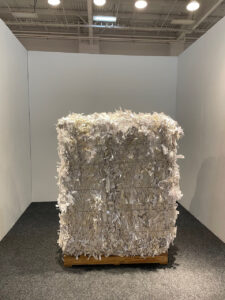
At some point someone had the excellent idea of try- ing to recreate the vibe of the original Armory Fair from February 17, 1913 which had a profound effect on American and international art when it first hap- pened at the 69th Regiment Armory at Lexington and East 25th St. The Armory Show, as this recrea- tion of an art fair came to be known with no irony whatsoever, was as clever as its namesake but the 2nd and 3rd and 4th iteration? Not so much.
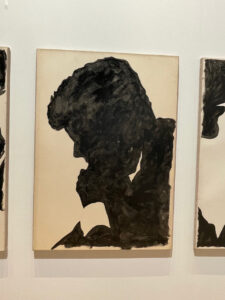
That said, some thirty years later, this year’s ump- teenth Armory Show, having nothing to do with any armory, was staged in the Javitz Center, the glorified shopping mall that could have come out of any USA city, but the cavernous behemoth of a building was the scene of much jubilation and anticipation, even if it happened to be largely unwarranted by the building or the art within it. New Yorkers seemed genuinely giddy at the thought that Covid was gone but sadly, returned in volumes and forms we can handle? Despite the odds, buoyant spirits abounded! There was a palpable feeling that people were glad to be at the Armory Fair this year and seeing each other, if not the art.
ARMORY SHOW
My first observation was that the colors emanating off the partitions were wild this year, another indica- tion of our collective festive, hopeful but cautious mood. As I walked around the city in general, I had the feeling spirits were high and as I got further from the Javitz Center, the art became even better and buoyancy bigger.

My annual trip to the likable Art on Paper Fair gave me an idea: maybe the way out from this art fair glut is for each fair to have its own specialty, the way Art on Paper does. Couldn’t we have a Color Fair, a Black and White Fair, a Tidy Fair, A Sloppy Fair, A“Du- champ is God Fair, a We Hate Duchamp Fair etc.? A few years ago there was a lot of modernism at the “other” big armory uptown that I found refreshing. (I call it the Paul McCarthy armory.) This year the way downtown fair at the Battery was intentionally 20th Century-focused and laudable for that reason. Each fair could be organized not by what galleries could afford it, but by what is actually in it. I would cer- tainly prefer that to the present hierarchical caste, or if you are one of the unlucky ones, cast-off system that unsubtly trickles down to baskets of deplorables with spirit and freedom increasing as one descends the striae.
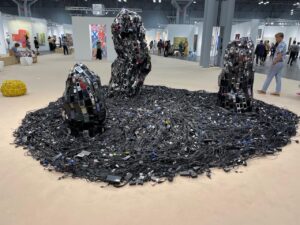
Jean Shin Image: Mark Bloch
Anyway, I will come back to the Paper fair. Let’s be- gin with every year’s mothership of misnomerism, the Armory Show which this year looked grand and bland with little notable, memorable or important including its centerpiece, Jean Shin’s Huddled Mass- es, presented by Praise Shadows Art Gallery (Bos- ton), a big heap of dated cell phones and wires. A thousand old flip phones formed three monuments rising out of a thick stack of wires, cords, mouses and the occasional external hard drive on the floor like Jean Arp blobomorphic shapes from the left for dead smartphone 1.0 era.
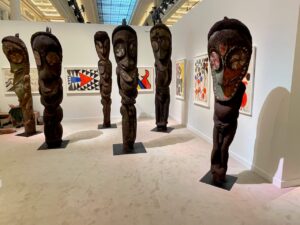
But let’s jump in. I liked the very colorful Pepe Mar works in both two and three dimensions at the Da- vid Castillo Gallery. I was amused by his surrealistic closeups of faces in mixed media combinations of found objects and acrylic on board.
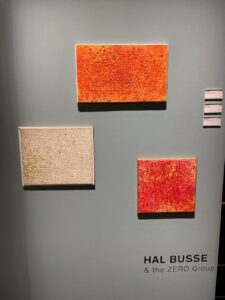
I also enjoyed a 3D sculpture by Homa Delvaray, (2022), of a “pick axe” —part of the artist’s “Khásh series “ in steel, full leather, PVC, silk screen and dig- ital print embroidery, part of an edition of three ob- jects, in a group presentation by Dastan Gallery from Iran.
Speaking of exotic locales, a city map called Our Town from 2023 was depicted by Grayson Perry for the Paragon Gallery from London, specializing in prints. This etching from an edition of 68’s red map under a blue sky sectioned off parts of a town with place names like Smug, Extremis, the corner of Apa- thy and Contrary—cartographed human concerns,
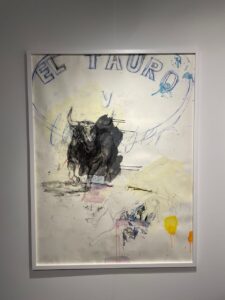
to the Island of Sincerity, from Suicidal Ideation to Binge Watching— with Vulnerability Castle jutting above the skyline. On the roof of one house it said “Follow your dream” and on the side “Struggle is good” in this user-friendly diagram of what’s inside our heads as urban landscape.
Diagrams and maps do cut to the chase. White on black diagrammatic creations by the artist Kameelah Janan Rasheed from Nome in Berlin also caught my eye. Cursive writing, printed writing, diagrammed sentences about gestures with arrows, lines and lists. Check. Pierogi also showed diagrams. Mark Lombadi’s work Banca Nazionale del Lavoro, Rea- gan, Bush, Thatcher and the Arming of Iraq ca. 1979- 1990 was a long 1995 graphite on paper piece with lots of family tree-like clusters of info. Intricate hand drawn names of individuals, arrows drawn with drafting equipment indicated smooth arcs of flow- ing money and power passing through Dan Quayles, Attorney Generals, Presidents of Romania, deals, re- search, intelligence agencies, Alexander Haig, the governments of Iran and South America and back to Margaret Thatcher and a Saudi bank. Tha’ts the piece: the flow of information. Need we trick up info with art?
Nearby, allso at Pierogi was a Sermin Kardestuncer photograph of ”This Pebble.” The actress Giulietta Messina staring at a little rock while starring in a work of art just as she starred in La Strada for Fellini in 1964. The fiber it is mounted on complements her as does another half-icon, half-diagram work next to it. It’s sculpture, signage, a glam movie still, a 21st century diagram, all pointing the way to something informative but elusive.
Big dog heads on full scale realistic human bodies at Invisible Dog New York positioned humanesque dog-men and dog-women on human bodies holding cell phones and standing in for us. With a pack of cigs in a pocket, two dogs fumble with a tape meas- ure, working at the art fair booth. A she-dog with a proper wool suit looking very wealthy holds a leash leading to another dog on all fours. All these canines have the same realistic hound face with floppy dog ears but human eyes.
Meanwhile big colorful Willem De Kooning-esque 1951-ish “Woman”-like faces are in this year. Sloppy faces abound. Here, a 5 over 5 grid of big Thomas Dil- lon closeup Ab Ex portraits at Shrine (NY and LA) sport a range of super colorful Pollock-style action painting jumbled-up faces: pensive looks, hideous smiles, even a satyr-like monster head and shoul- ders.
Elsewhere, not faces but entire De Kooning “Wom- an” figures: full body, full background mosaics—fragmented and yes, colorful but muted. Expressive and in a whirl by Cameron Welch, at Yossi Milo Gal- lery. Two much bigger works with less primary colors but a similar feel: high Ab Ex vibe but with a well- thought-out, expensive edge for 2023.
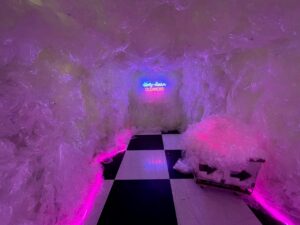
Tern Gallery from Nassau is showing artist April Bey in a very festive display that thankfully breaks the mold with earthy turquoise and pink walls. Very so- phisticated paintings of people of color, gorgeous portraits of women wearing swag are labeled as such over a lady in a tilted red hat. In another that de- serves a closer look, the subject with a Carmen Miranda-like headdress is wearing a nautical helmet too, its surreality enhanced by two bunches of ma- genta bananas on either side of the framed work. Across the space, jumping off the canvas in three di- mensions with raised surfaces is more 3D fruit and 3D flowers in a vase.
Finally, an awkward but charming choppily dancing puppet about 1/4 the size of a real person by the late Dennis Oppenheim is called “Theme for a major hit.” Thank you Wooson Gallery for this flashback. This 1974 motor-driven marionette reminiscent of the artist as a younger man now emits mid-70s hu- manity. The puppet reminded Oppenheim of his for- mer self and it whispers now we also can’t go back. But stuck here under the Javitz Center steel, we’re glad to see each other healthy. So let me mention a few other standouts at some of the other fairs:
ART ON PAPER
A giant rectangular bale (4 foot cubed?) by Billy Du- fata combined paper, stainless steel wire and wood to create a sculpture that was a beautiful symbol of this fair— care of Fleisher/Ollman of Philadelphia. But for me the show’s stand out was Ariadni Vitasta- li, showing with Donopoulos International Fine Arts from Thessaloniki, Greece. She made an art of tur- moil look very pleasing with her masterfully applied strength. Not avoiding conflict, paint, graphite and oil sticks collide under her powerful hand. Popular culture in the form of her Big Foot series battled Greek myth. Within that mythical world, her inter- pretation of Leda and the Swan, created last winter, mixed it up with The Abduction of Europa. In both those myths, Zeus takes the form of an animal in order to seduce (a woman.) Vitastali’s hazy erotic read- ings of today’s gender and identity boundaries and interactions make for a topical game in which her technique and imagery can clash. Centuries of art history also manifested themselves as the swan and a bull, beautifully labelled El Toro in one work, all but intertwined in their dance with Leda/Europa, the subject and perhaps a stand in for the artist—or maybe not. The sexiness of a swan weaving around a woman attracted many artists over the years, from the Symbolists to Cy Twombly, becoming taboo and messily complicated like Vitastali’s combinations of media and subject matter that tempt the imagina- tion in a 2D blur. Bits of writing, some crossed out, some circled create choppy fragments of graphite exclamations surrounded by visual expressionism: a turquoise wash interrupted by two darker swatches of blue; a standing woman holding a swan behind strategically placed reds and purples; dancing pinks and greys circling like Matisse’s dancers; a pair of figures with flailing arms, one male, one female, dodging chunks of grinding pigment: fleshy tones, yellows and orange body parts sketched quickly; blues, reds, and plenty of negative space under the title of the plainly labeled myth. And looking pound- ed down like a giant rubber stamp, an exquisite print of a dark red female figure on the ground motions through the flames like an Artaud injunction with a regal bull preening nearby.
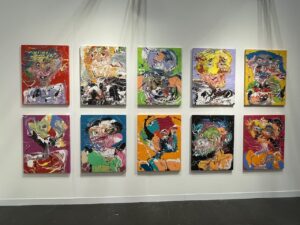
Another Greek artist, Costas Picadas, working with an app called Equinox, the biggest AR (Augmented Reality) company in Europe, was tucked into the fair’s corner but his art penetrated deep into virtual space as reality took a back seat to his bio-organic creations of a human brain sprouting a tree. The app, sharing his vision in an immersive, interactive environment is particular to each viewer who sees his work on their hand held device by scanning his QR code. It even worked when I got home.
Gabriel DaSilva’s +GALLERyLABs from Buenos Aires and New Haven showed Josef Albers prints, and sev- eral Argentines including serigraphs by Luis Gro- sclaude who likes Miro and pre-Columbian Mayan calendar art, Karina Burato, who does cut and em- bossed paper prints with India ink, and Mir Diaz Araya whose shimmering, gold, hand-cut mandalas
are sensitive and delicate, utilizing shadows and transparency.
But for me the Argentine Estela Mydlarski’s fumage works—mean- ing fire manifesting as controlled marks on subtle papers— provided the most memorable and intimate dialogue with materials here. With lots of facility, she uses candle smoke, soldering irons and other mysterious tools to make amazing black and grey artifacts.
At Accola Griefen Fine Art, I was struck by Jaida Grey Eagle’s Por- trait of Mikayla, a cyanotype with elk teeth, (2023) that was an image of another of the gallery’s artists, Mikayla Patton, who created a tryptich nearby, Shedding (2022), a laser etching with glass beads on handmade paper. Jaida Grey Ea- gle’s striking image of the teeth re- sembling cats or fish in black and white, coming off the subject’s body on threads, was unique and captivating.
Finally, I have to mention Cécile Plaisance’s lenticular photography from Gallery K and Y in Paris in which simply passing by the art re- veals a naked, sexy woman— pre- sumably stunning model Olga Kent—exposed from under hijabs and nun’s habits and other reli- gious garb as one walks past the high tech prints in wooden frames. In editions of 8 these are simulta- neously funny, irreverent, political and gorgeous.
SPRING BREAK
Since 2020, the cubicles of the former Ralph Lauren headquarters at 59th and Madison Avenue have pro- vided the 100 plus exhibitors and curators of Spring Break a place to show their wacky wares in site spe- cific mid-town presentations that are Old School Downtown-like collaborations between artists and curators.
Speaking of which, I was glad to see the work of the East Village choreographer, filmmaker, and pho- tographer Jo Andres, who began in the dance world and then branched out with dozens of ubiquitous flyers around town in the 80s announcing her multi- media gigs. These flyers, her films and some other
bric-a-brac at reasonable prices paid a moving trib- ute to the late artist curated by Laurie Berg and Stephanie Acosta.
The fair’s most memorable installation for me was “(dirty~clean) Cleaners” by Laure Droguoul and cu- rated by Alix Bickson. The Maryland artist created a plastic cave of the familiar and apparently deeply evil low density plastic dry cleaning bags. A lone rack with some random hangers on it and the pink-laven- der glow from a neon sign deep artfully positioned within the non-biodegradable LDPE plastic #4 toxic birdsnest of thousands of crumpled bags was all that was required to create a strong political statement and the perfect counterpoint to the fair’s checker- board floor. Tell your dry cleaner to stop! I was also taken with the work of Gvantsa Jishkariani
from the country of Georgia, a Tbilisi-based multi- media artist. In an installation, she explored tradi- tional crafts, making her own investigations with irony and courage. She was also a curator and found- er of the Tbilisi-based Why Not Gallery dedicated to fellow Georgian artists. But her own embroidered fringed pink and green banner saying, “Citizen of Nothing,” against a corrugated silver industrial sur- face, hung next to a picture of a woman’s face with broken glass strung like a necklace hanging down over the face and down the side of her head, past her ear and covering her mouth as she looks out at the viewer seemed like a “f.u. to the old USSR. Two sewn bags hung from either side of the sash and spray paint on the silver background completed the tab- leau. In the past, I saw similar banners by Jishkari- ani carrying phrases like, “Through the blizzards through the wars,” “Brutal honesty,” “Magnitude of fear,” “History of Pain,” “History of Shame,” and “Minor Injustice.”
Another Eastern European, Viktoriya Basina, showed her “Folk Toys Series,” a powerful roomful of religious icons with realistically painted female sub- jects flipping off the viewer with what appears to be a sacred hand gesture. The MFA grad from the Mos- cow State Academic Fine Arts Institute is a very tal- ented painter. The images are intricately cut silhou- ettes that hug the edges of the would-be religious objects making them free-standing altars.
The only notable display at this fair “manned” by a male contingency that I loved, members of Yea Man Spa Global, happened to be “Fuck Stories,” a call center, though, that was curated by Caroline Wein- stock. Viewers were invited by the friendly, respect- ful gents to sit down at the desks and pick up the red phones from a previous era in which they would hear recordings via robotic voices of actual sex en- counters shared by the public at a hotline—(646)- 572-6998—that were then disguised to protect the caller’s anonymity. “You can totally still submit a fuck story if you want to,” said both Weinstock and a seedy flyer that looked like it was photocopied from the same Old School as the touchtone phones on every desk.
INDEPENDENT
Finally at the classy Independent show all the way downtown by the Staten Island Ferry, a fancy build- ing was gussied up even further with lots of 20th Century art in a classy offering.
Jane Lombard Gallery presented the artist Allan Wexler whose schematics for a four-handled broom and a four -handled cup caught my eye and then took me back to the diagram theme I had witnessed
earlier with Wexler’s single grip coffee cup and a saucer under glass. Floating above them in a frame were mounted to-scale diagrammatic foldable mock-ups on paper to be used to recreate the cup and saucer with fascinating numbers in every mi- ni-quadrant, giving the endeavor a Fluxus-like use- less and OCD feel simultaneously.
Speaking of groups that took shape in the late 1950s, the Germany-based Zero Group of people born in the 1930s merited a nice and surprising little pres- entation here. The work spoke for itself via the BE Gallery. Heinz Mack, a Zero founder, had an alumi- num “Light Relief” from 1959 and an untitled piece from 1966-67 with synthetic resin on wood. Gunther Uecker, another founder, though one who came along later (born in 1930), showed “Tree:” nails on black paint and an ash-glue mix on a tree trunk, a 2003 work very reminiscent of his early Zero works. Walter Leblanc’s 1959 “Sand Perforations” with sil- ver gouache on paper with a delicate texture on sil- ver paper which required a much closer look. Finally, the recently “rediscovered” woman Hal Busse, born 1926, died in 2018, was represented with three ele- gant little red, orange and white squares with ab- stract, industrially-painted raised surfaces in the form of dots, typical of the movement, all Untitled. An oil on hard board from ’58 and two mixed media works on hard board from ’59 added to works by Busse.
Everything at this fair was well done. Warhol por- traits curated by Bob Colacello for the Vito Schnabel Gallery, elsewhere several Calder works were mixed with a forest of enormous surrealistic “primitive” forms—totemic sculptures from Vanuatu at Venus Over Manhattan downtown and Peter Nadin paint- ings at Off Paradise. I think my favorites, however, besides the giant Vanuatu monuments, were goopy black enamel works on paper by Sergio Lombardo at 1/9 unosunove featuring silhouettes of politicians and called “Typical Gestures.” Two simple profiles of JFK’s head brought me back to my childhood. Here was imagery that was immediately recognizable, easy to understand, yet thought-provoking, and that connected me, unexpectedly, with deep feelings of both nostalgia and tragedy. If art fairs can do that, then I suppose we should allow them to continue.

